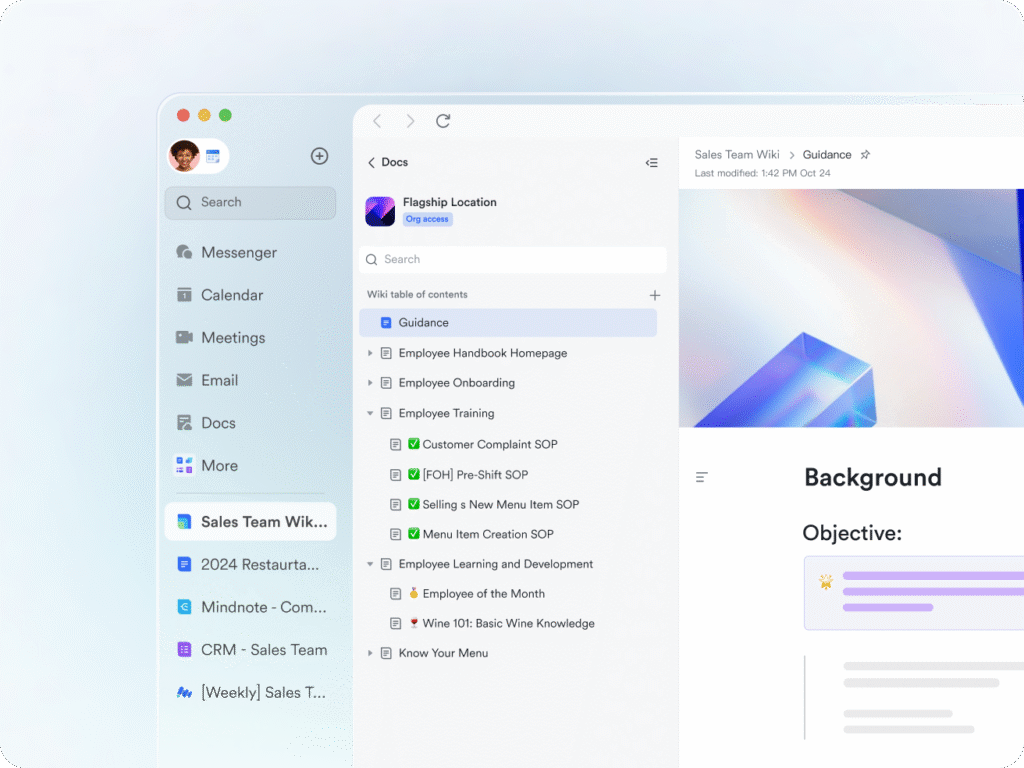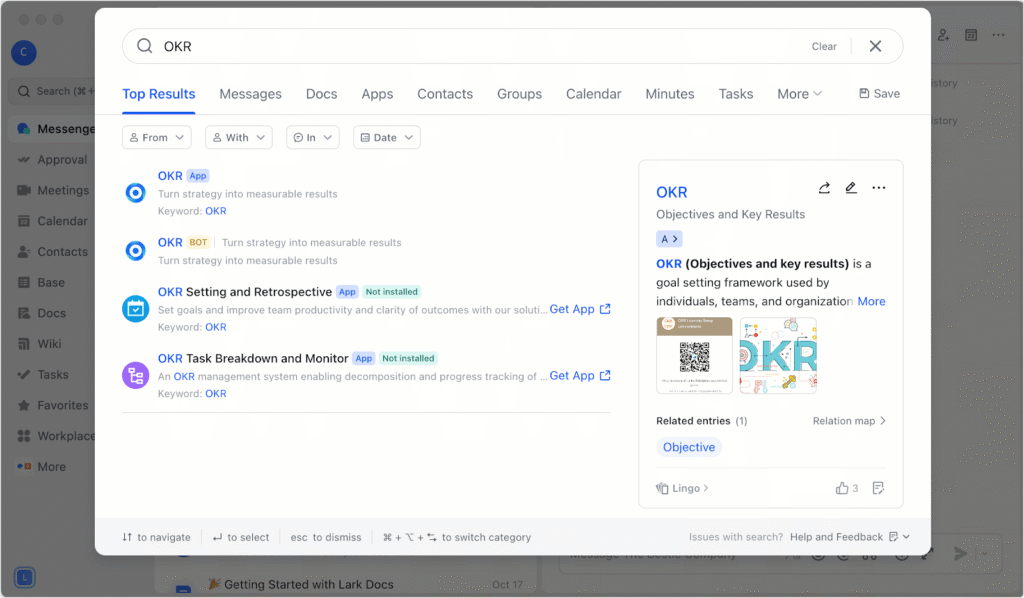
Point solutions can be attractive at the beginning stages of growth. A team needs a scheduling tool, so they add a calendar app. A different group needs task management, and they buy a separate tool. Before long, the organization has pieced together a collection of software that solves one specific issue. The problem is that growth does not happen in vacuums. Sales are dependent on operations, marketing is dependent on finance, and product teams need insight from support. Point solutions create fragmentation, which forces employees to manually transfer information between unconnected systems.
Connected platforms are the solution to fragmentation through unifying workflows. Modern project management tools like Lark do more than create efficiency-they help organizations grow smarter. Instead of managing multiple apps, businesses get one single place where communication, knowledge, and accountability collide. That connection turns growth from change in chaos, into growth that is sustainable.
Lark Base: Growth built on shared foundations
As businesses expand, scattered data becomes one of the biggest barriers. Each team often maintains its own tracker, making it difficult to get a full view of progress. Leaders spend hours reconciling reports, and employees feel disconnected from the larger picture. Lark Base changes this by providing a single, customizable hub where projects, responsibilities, and outcomes are aligned.
Marketing may use Base to map out campaigns in Kanban view, while operations relies on timelines for supply chain planning. Sales can use Lark Base to build a CRM app, linking customer histories directly to delivery milestones. This means that when a client signs a new contract, other teams immediately see what's needed to deliver. Instead of working with partial information, everyone contributes to a shared record of truth.
Over time, this transparency compounds into long-term value. Teams no longer waste energy chasing updates or duplicating work, they focus on delivering results. Growth accelerates not by working harder, but by working with clarity.
Lark Calendar: Aligning time with expansion

People often don't realize how important time is when a company is growing. Usually, simple solutions take care of individual scheduling, but they don't usually relate deadlines to main goals. Because of this, different departments might move at different speeds, and if one thing is missed, it can mess up the whole company. Lark Calendar puts time management right into how you work, so everyone stays on the same page as the company gets bigger.
When you set goals in Base, they automatically pop up in Calendar, where everyone can see them. This lessens the chance that messed-up schedules will wreck projects. For example, releasing a product becomes something everyone's working toward together, instead of a moving target. Workers don't just see when their own stuff is due; they see how their work fits into the big plan.
Calendar also makes things better for workers by linking meetings to what's on the agenda and to documents. People come to meetings ready to decide things, instead of spending time catching up. Automatic time zone changes make it easier for people all over the world to work together, making distributed work less of a hassle.
By putting time into the same system as planning and doing, Calendar makes sure growth is steady. Companies keep their word, meet what customers want, and grow without worry.
Lark Docs: Making collaboration a driver of growth

Collaboration often slows down as organizations grow. Point solutions for file storage or word processing may work in isolation, but they rarely keep up with evolving workflows. Teams end up working in silos, creating duplicate documents and losing track of the latest version. Lark Docs turns collaboration into a continuous, transparent process that drives execution.
Instead of drafting documents separately, employees co-edit in real time. A cross-functional team preparing a market expansion plan, for example, can contribute simultaneously, marketing adds campaign details, finance forecasts costs, and operations refines delivery logistics. Everyone works in one place, reducing confusion and speeding up progress.
Docs also link directly to Base and Calendar, ensuring that strategy connects to execution. A finalized plan doesn't sit idle—it becomes part of project records and timelines. This seamless connection prevents knowledge from being lost and ensures that collaboration translates into outcomes.
The impact on growth is significant. Employees feel their input is valued, decisions move faster, and knowledge compounds over time. Collaboration is no longer a bottleneck; it becomes a competitive advantage.
Lark Approval: Scaling decisions with confidence

Decision-making becomes more complex as businesses grow. With more employees, clients, and stakeholders, the number of approvals multiplies. Point solutions often handle these through email or standalone tools, leading to delays, inconsistencies, and frustration. Lark Approval makes decisions transparent and scalable by embedding them into connected workflows.
Employees submit requests in a structured system, where progress is visible to all. Instead of wondering whether a budget was approved, they can track its status directly. Managers no longer sift through crowded inboxes to find the latest request—it arrives automatically in Approval.
Because Approval supports an automated workflow, routing, reminders, and escalations happen seamlessly. A purchase request reaches the right manager instantly, and overdue items trigger reminders without manual intervention. This predictability reduces bottlenecks and ensures growth doesn't stall due to slow approvals.
Over time, Approval creates confidence in decision-making. Employees trust that processes are fair and consistent, while leaders trust that decisions are executed reliably. This confidence becomes a foundation for scaling sustainably.
Lark Wiki: Preserving knowledge through expansion

As teams get bigger, one thing that often gets lost is what everyone knows. Info ends up stuck in people's computers or just talked about, which makes it hard for new folks to get up to speed. Simple docs don't fix this since they're messy and hard to find. Lark Wiki fixes that by keeping all the company's info in one place, where everyone can find it.
Teams can keep handbooks, rules, and guides on the Wiki, so there's just one place to look for stuff. New people can find what they need right away, and people who've been around can keep up with how things change. Instead of random notes, everyone uses the same correct info.
Since Wiki works with other Lark stuff, info stays fresh. If you write down a new way of doing something in Wiki, you can link it to tasks or approvals, so it actually gets used. Over time, this makes everyone share what they learn, so the company gets smarter instead of forgetting things.
By keeping things consistent, Wiki helps companies get bigger without losing the know-how that made them great in the first place.
Lark OKR: Keeping growth aligned with strategy

Possibly the biggest hurdle to scaling is alignment. Point solutions are all about single outputs, but they hardly ever tie daily work to the organization's goals. This means that teams are engaged in tasks that are busy that do not ultimately lead to growth. Lark OKR closes that loop by enabling strategy to flow directly into execution.
Leaders articulate objectives and measurable key results that reflect growth priorities, such as entering a new market or improving customer retention. The objectives are then visible across the organization so that everyone knows what to focus on.
Progress reporting flows seamlessly from Base or Tasks to give leaders more insight. They see it every day and do not have to wait for a quarterly report to learn if their initiatives are progressing as planned. That responsiveness will allow them to shift responsibility quickly and maintain growth in a changing environment.
For employees, OKR gives them meaning. They understand not only what they are working on, but also why it is important. Meaning fosters engagement and growth is viewed as a shared purpose, not just contribution towards a number.
Conclusion
Isolated solutions may address individual issues, but they can be outpaced by the complexities of growth. They create silos, promote increased duplication, and obscure accountability. Connected platforms like Lark eliminate this fragmentation by providing clarity, structure, and alignment. Base offers a shared foundation for information, Calendar aligns all people and resources with time, Docs brings transparency to collaboration, Approval makes outreach and decision-making scalable through automation, Wiki captures organizational knowledge, and OKR connects growth to strategy. Together, they create smart growth, which is sustainable, predictable, and aligned.
For modern businesses, the choices are straightforward. Point solutions may work in the moment, but connected platforms create value over time. Growth isn't always about growing faster; it's about growing smarter, with the trust and clarity that only connected workflows can deliver.


 Follow us
Follow us Follow us
Follow us














